![How to Create Evergreen Content That Drives Traffic For Years [Tips & Examples]](https://media.coschedule.com/uploads/2021/12/evergreen-content-header.png?w=3840&q=75)
If you’ve spent any time reading blogs about how to succeed at
content marketing, then you’ve probably come across the advice to create evergreen content.
Publishing evergreen content solves the challenge of content marketers to consistently create and publish new posts online, especially those that might have shorter lifespans like news, updates, and trends.
In this post, we want to show you exactly what this content marketing strategy is and why it remains to be beaten as one of the best ways to grow your business online. Later on, we’ll walk you through step by step how to create an evergreen content strategy that is geared towards results and pays your business back in dividends.
What is Evergreen Content?
Let’s first start with what evergreen content really is. To understand it best, we should take a look at its opposite: timely content.
Timely content is that which is topical, meaning the relevance is more immediate but also relatively short-lived.
Examples of timely content are news articles reporting on breaking news, reaction or opinion content about new updates from a company or product, or any kind of content that relies on
trend or news jacking.
Its direct opposite on the other hand is evergreen content. As you might guess, this is content that stands the test of time. Evergreen content is likely to be the kind of content that many users will search for through the years, making it great for SEO and any business that relies on content marketing.
It’s not unusual for a business to adopt a content marketing strategy that uses both topical or timely and evergreen content. In fact, they can even complement each other nicely. While evergreen content might take time to show results through search, topical content can ride the tide of a trend and get quicker, albeit shorter, traffic.
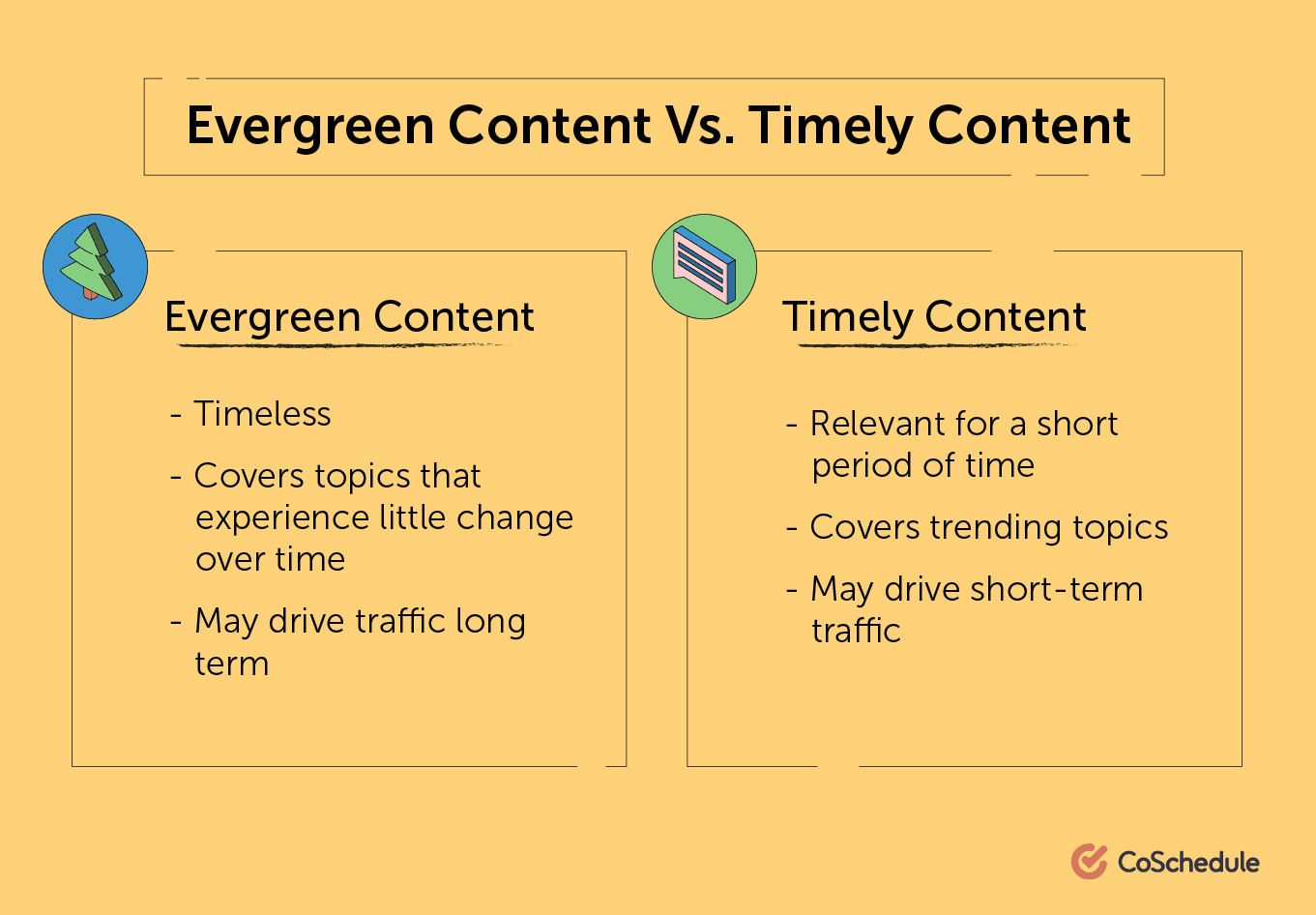
Evergreen Content vs Timely Content in Action
Let’s take a look at how this might work for a fitness and nutrition business.
If the business noticed that some new type of diet was starting to become viral, then they might create timely content around that new craze or fad. This works great if there aren’t too many players already writing about the topic, even more so if they commit to
creating the best post that blows the competitors out of the water.
On the other hand, this business might also take time to create more evergreen content that they know customers will always search for. These could be blog posts about how to sustainably lose weight, bodyweight exercises, and supplements that support a healthy lifestyle.
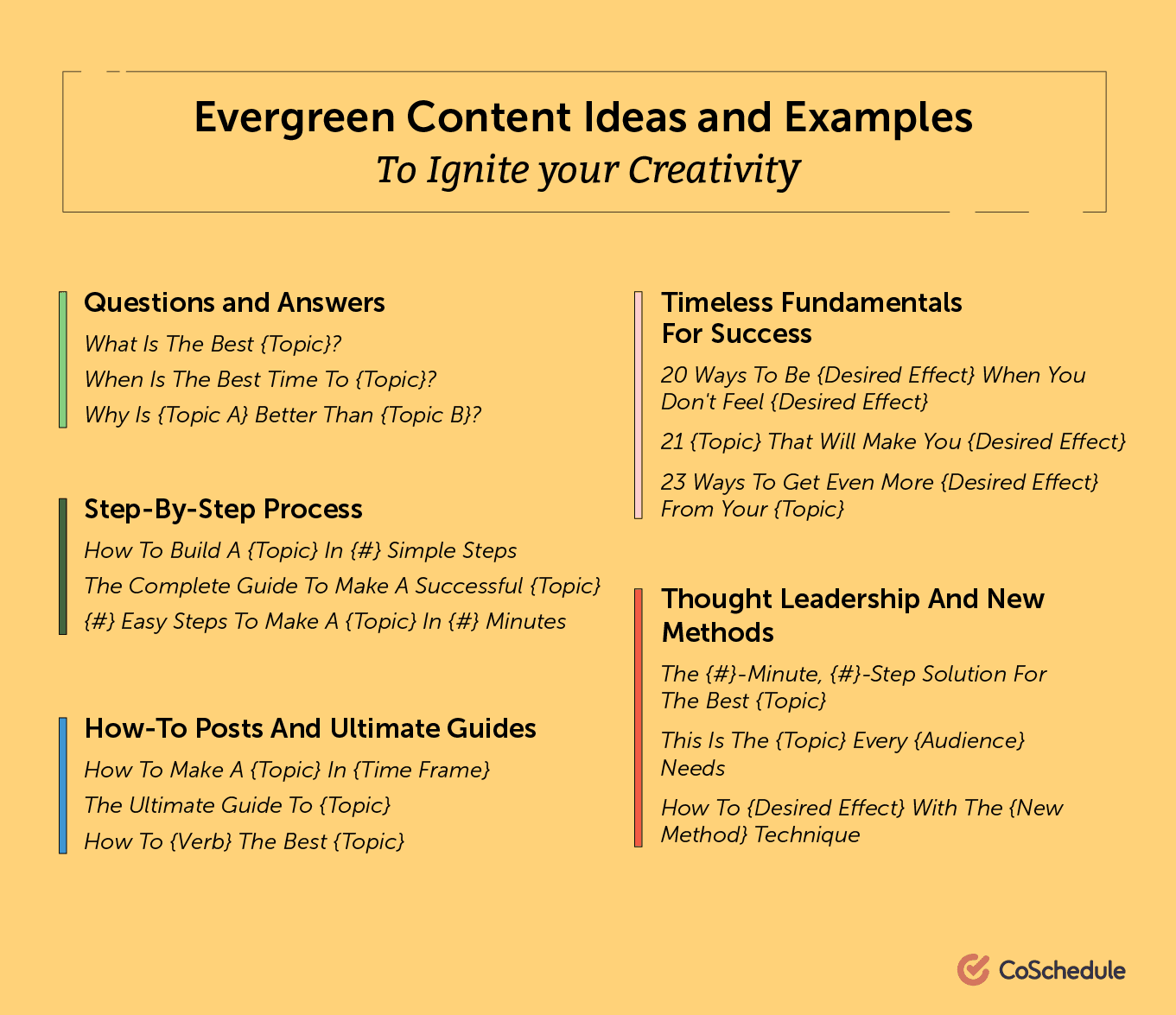
Reasons to Publish Evergreen Content
Even though timely content tends to rake in views quickly, just like the tides of the ocean, it can quickly die down as new trends and information pop change.
Here’s why you’ll want to focus most of your content marketing efforts on evergreen content.
It Withstands Time
We already mentioned how evergreen content is one of the best ways to make the most of your content marketing efforts. Because it can last for years, that means you get the most bang out of your buck for a piece of content versus its timely counterpart that might only last weeks or months at most.
You can use evergreen content endlessly in your content marketing, either to repurpose for other platforms or to make them better over time. And because you’re giving your evergreen content time to “mature,” it increases your chances of ranking on search for certain keywords.
It’s Great for SEO
Aside from being a great investment for ranking in search, one reason you want to have evergreen content is for its potential to
increase your site’s rankings overall through backlinks.
If you can
create the most valuable evergreen post, other publishers and content marketers will be more likely to link back to your content, boosting your site rankings even higher.
Plus, if your team decides to do some outreach to publishers and bloggers to grow your backlinks, you’ll have an easier time with evergreen content. Between long responses and follow up times for publishers, evergreen content is the best kind of content to work with for your link building outreach.
Consistently Generates Leads
Finally because of the evergreen nature of your content, one benefit that comes from this is that it can consistently generate leads over years.
With topical content, you might be able to get a boost in views in a short amount of time but that doesn’t always guarantee qualified leads.
After all, depending on the niche, some users may only search for topical content out of curiosity, and this might affect your chances of getting people to sign up for your lead magnets and offers.
You won’t experience this challenge as much with evergreen content. If users find your evergreen content through search, that is a stronger signal that they have genuine interest in your topic over simple curiosity about a trend or piece of news. Even as you keep promoting evergreen content through your other platforms, you’re also reaching people who have opted in to following you and will be more likely to sign up to lead magnets on your site.
How to Create Evergreen Content for Your Business
If you’re convinced that evergreen content is the way to go for your content marketing strategy, the next step is learning how to create evergreen content that really grows your business. Follow these steps to get started.
1. Identify the Pain Point You Want to Solve
Like your paid products and offers, your evergreen content solves a particular pain point of your ideal customers.
Pain points are not yet content topics; they instead point to a deeper reason why your audience might be interested in said topic. For instance, if someone is searching for tips to quickly grow an Instagram account, then their pain point might be not knowing proven strategies that really work or they’ve been using strategies that deliver slow results.
If you’re already selling paid offers, then the good news is that you can use this as reference to the pain points you’re trying to solve for your customer.
However, it also helps to look beyond these direct pain points and consider similar ones around your niche. You might be able to brainstorm topics down the road that work great for SEO while providing an avenue to promote your services and products.
How to implement this step
Here are some actionable ways you can start identifying your customers’ pain points:
- Start with your own assumptions or insights. If you already have a business that is serving your customers, you likely know what pain points you’re solving.
- Consider sending out a survey to your customers. There’s no such thing as too much customer research. You can still glean more insights directly from customers through a survey that asks them about their problems and what they look to your business for.
- Conduct in-depth interviews or focus group discussions. To get the meatiest answers from customers about their pain points, you can interview both existing customers and ideal customers that may be using a competitor’s products. This way, you can cast the biggest net around what pain points you can solve for your customers.
2. Choose Your Evergreen Content Topic
When you understand the pain points your customers have, you can move on to brainstorming actual evergreen content topics that you’ll later create. Even just one pain point can produce a significant amount of topics, so you’ll have plenty to choose from later.
Here’s a quick litmus test to determine whether or not a topic is truly evergreen or if it toes the line toward topical:
- Will this topic be relevant at least a year from now?
- Is this topic something that emerging markets will always be searching for?
- Can this topic be reshared on other platforms over and over without seeming outdated?
When you think of topics, you can then start to frame them as working titles. This way, you can see exactly how to structure and position your content, even if you think of related topics along the way.
Here’s an example. Say you came up with the topic “creating Facebook ads” that solves the pain point of customers who don’t know how to effectively leverage this advertising method.
As you brainstorm working titles for this topic, you might find that this topic can be branched out in different ways like the following:
- How to Create Effective Facebook Ads that Rake In Sales
- The Most Important Facebook Ad Metrics to Know for Your First Campaign
- Elements of a High Converting Facebook Ad
Of course, it’s not uncommon to see updates and new information come up that could affect your evergreen content. In certain niches like tech and software, for example, changes and updates are expected and could affect the relevance of your evergreen content.
However, later on in this post, we’ll show you what to do when it looks like your evergreen content could use a little freshening up.
3. Conduct Keyword Research
After you’ve brainstormed your topics and even working titles, it’s important to check whether writing these posts will be worth the effort. Enter keyword research.
When you
conduct keyword research for certain topics and keywords, you get to determine whether or not there is actually any demand for the topic you’ll be creating content about. Monthly search volume can tell you the potential amount of viewers you can stand to reach with a particular keyword or keyword phrase.
There is no actual benchmark to what is considered a healthy monthly search volume, especially as niches differ in size.
You might belong to a very specific and narrowed down niche — say something like dog adoption or mental health for a specific set of people — so you can expect that any monthly search volume for specific keywords might be less than a more popular topic — say, digital marketing.

https://moz.com/blog/find-keyword-opportunities-without-historical-data
Tips to do effective keyword research
Whether you’re a keyword research beginner or have some knowledge about this tactic, here are some tips to get you on the right track:
- Focus on long-tail keyword phrases. As people rely more and more on search for just about anything, you can get your ideal customers’ attention when you optimize your content for long-tail (or longer) keyword phrases. For example, if your business was online therapy for people of color, keyword phrases you can target might include modifiers like “for Asians” or “for Black girls” or “for Indigenous men”
- Compare different keyword phrases in your niche. While there’s no average benchmark for a decent monthly search volume, you can still infer what it might be for your own niche by comparing different keyword phrases from different topics. For example, getting a monthly search volume of 6,000 views for one topic while another topic gets 60,000 might tell you that your first keyword phrase is either too narrow or doesn’t have any demand.
- Invest in the right tools. There are certainly a number of tools that give you basic keyword research features for free, including search volume and competition, but more intermediate marketers might stand to benefit from paid versions of these tools. Look into tools like Serpstat or Moz to see what suits your needs best.
4. Pack Your Evergreen Content with Valuable Information
We’ve hinted at this a few times in this blog post, but if you want to create evergreen content that gets results, then you have to prioritize quality over simply quantity.
While it’s true that longer blog posts can rank higher in search, at the end of the day, you want your audience to get a ton of value. Because of this, commit to creating evergreen content that is only as long as it needs to be — not packed with fluff for the sake of a word count.
If you do prioritize quality over simply word count, you can still create an evergreen post that is about 2,000 words and can rank on search. This is because if you really packed your post with value, then you’d be providing enough information and insight that will pad up your blog post without needing to resort to fluff.
For example,
this blog post on the complete guide to outsourcing has a ton of value that shows readers exactly what they need to know about the topic. Reading through the post also shows that sections don’t repeat themselves, and the information gets more detailed and informative the deeper it goes.



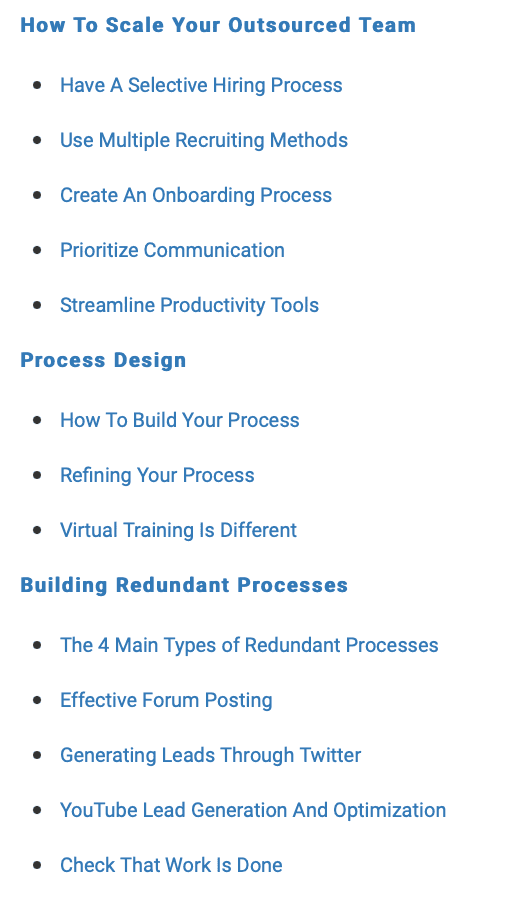 The blog post on outsourcing linked above is so massive, it has its own dedicated table of contents, filled with SEO-friendly keyword phrases.
The blog post on outsourcing linked above is so massive, it has its own dedicated table of contents, filled with SEO-friendly keyword phrases.
While the example above might be a massive post of about 3,000 words at least, there are exceptions to this rule. Given the mindset of creating high value evergreen content that is only as long as it needs to be, you might then come up with extremely valuable posts that might be shorter than others, and that’s okay.
5. Pay Attention to Its Layout and Design
It’s not enough to rank in search; you have to deliver exceptional reading experience for your audience as well. Not only will they be able to actually read through your evergreen content, but they may also be more willing to trust your brand and be more likely to sign up to your email list.
After, one factor that affects conversions is bounce rate, or how soon a user leaves your website after clicking through the first time. Even if you write the most valuable evergreen content piece in the world, not having proper formatting and design can ruin your results.
The longer you can
get readers to engage with your content, the better chances you have of turning them into qualified leads.
Tips for optimizing evergreen content layout and design
There are several best practices you can follow when it comes to proper layout and design for your evergreen content:
- Give enough white space between paragraphs. You can adjust paragraph spacing, line height, and also paragraph length. A general rule of thumb is to keep paragraphs up to 4 sentences long.
- Add visual breaks with images. Include any relevant visuals that help break walls of text. These might be charts, infographics, screenshots, or picture examples that illustrate your points better.
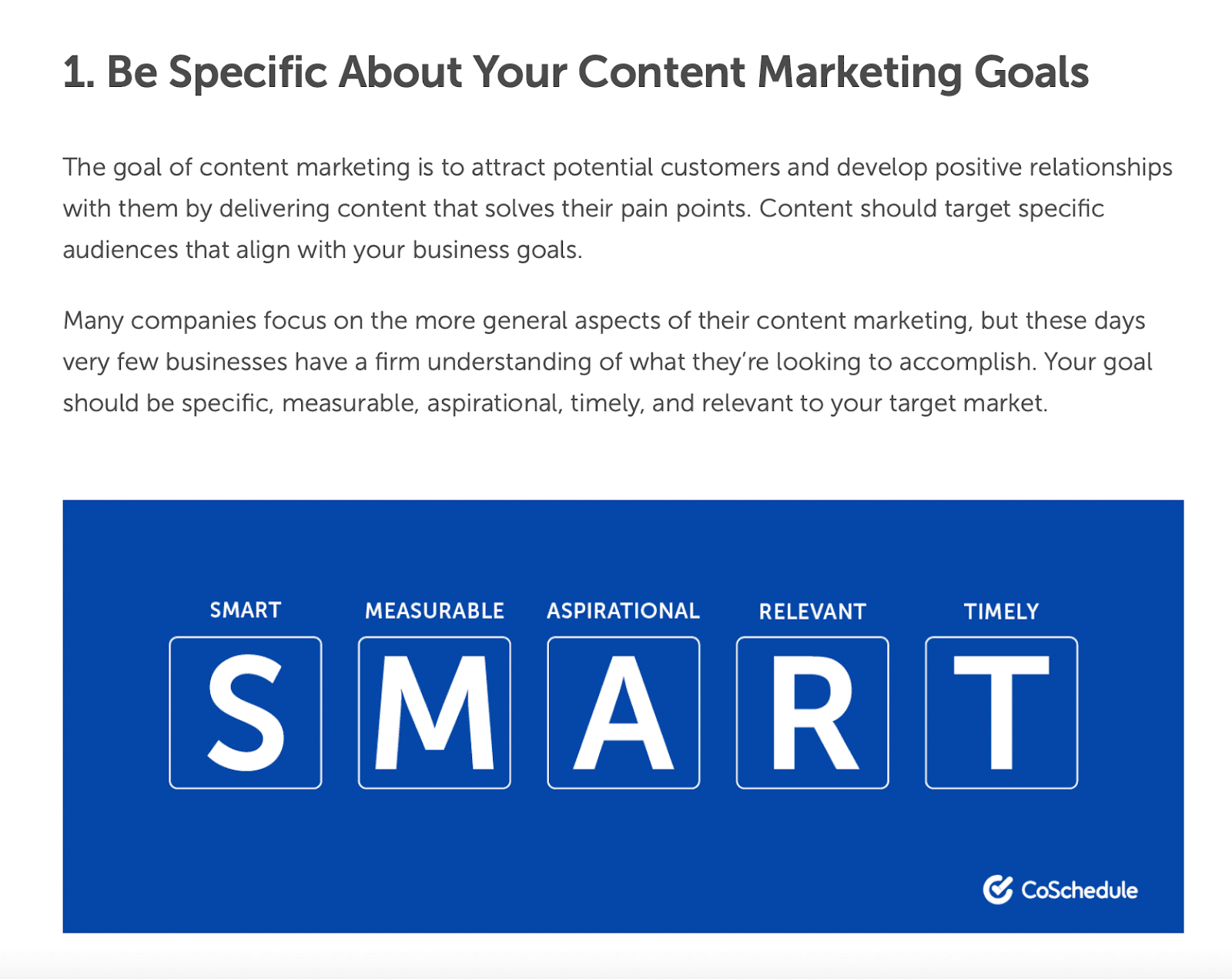
- Use readable, web-safe fonts. For best results, choose fonts that are easy on the eyes. You might use stylized fonts for headings, but these won’t always be the best choice for body text.
- Break down posts in subheadings. Organize your content into headings and subheadings to make your post skimmable and easy to digest or come back to.
- Include a table of contents. For longer posts, it doesn’t hurt to include a table of contents that helps readers navigate through sections faster.
6. Don’t Forget Your CTA
Finally, if you create evergreen content to generate more leads, then you want to make sure it’s sufficiently peppered with your call to action.
Include a call to action or lead magnet every few paragraphs or sections, and be sure to include this in your conclusion as well.
It helps if you create a call to action that is visually eye catching too. If you can’t use a popup or a ribbon, a simple colored box background or a mockup of your lead magnet inserted between paragraphs can go a long way.
If you do include your call to action as part of your content’s copy, then be sure to relate it to your content so it doesn’t feel out of place.
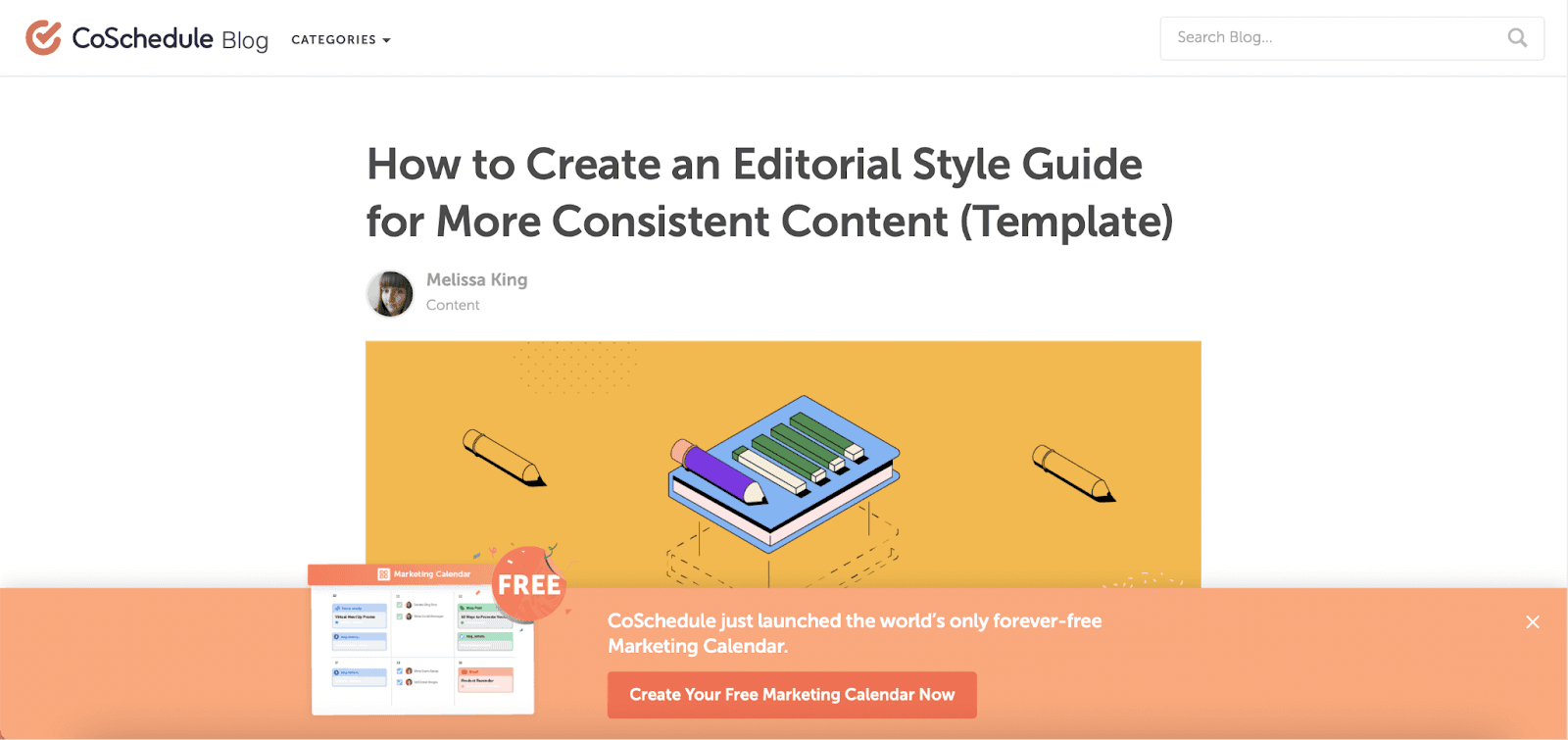
Evergreen Content Best Practices
AS you create your evergreen content, bear in mind these essential best practices that will help you make the most of your efforts.
1. Regularly Update Your Evergreen Content
Now, just because evergreen content means it stands the test of time doesn’t necessarily mean that your content never needs updating. We mentioned earlier in this post that there may be moments when information becomes outdated even in evergreen content, and that there was a way to manage these updates.
So if you’re wondering
what to do with old blog posts and evergreen content, you can breathe new life into them by editing them with more relevant information.
This makes sure that your content stays up to date and makes the most of your content’s performance, keeping it up or boosting its rankings the longer it stays up.
Another benefit of doing this isn’t for the blog post itself but even for your other content pieces on your blog — by updating old evergreen content, you can help other posts rank by linking to them within your longer evergreen post.
What you can update in old evergreen content
There are many ways you can keep evergreen content feeling fresh. Here are just a few things that might be easy to update and keep current:
- Dates (especially for posts that use date-centric hooks e.g. “Best Marketing Tips for 2022”)
- Data and statistics
- Quotes
- Examples
- Screenshots and images
- Titles
2. Humans First, Search Engines Second
Another thing to remember as you create evergreen content is to make sure you’re writing your content for humans first. While SEO should always be top of mind, it’s not enough to optimize and create your evergreen posts with search engines in mind.
Remember that search engines are designed to rank content that users read and engage with. While they’re imperfect, their ranking factors are based on actual metrics that point to user experience and satisfaction. So if you’re only trying to please a search engine, you might never actually rank.
Instead, commit to the key principle we’ve been mentioning in this blog post: make high-value, great content first.
When search engines see that your posts are keeping people on your site, are getting backlinks because people find them a valuable resource, or are engaging users more than the competition, that’s when search engines reward you.
3. Avoid Technical Jargon
Jumping off our last point about writing for humans, it may be best to avoid technical jargon. You can mention them when necessary, such as explaining technical topics, but keep this far and few in between.
Keep your tone conversational. You might have to try reading some sentences and paragraphs out loud to check if they’d be natural to read.
If you really can’t avoid jargon, especially in your industry, make sure it’s jargon that your audience already knows and would likely use. Certain content might need to mention jargon if used to educate and inform, but if it’s not what most people in your industry would use in a daily conversation, then it might not be worth using in your post too.
4. Continue Publishing Quality Content
Evergreen content does a great job in driving quality traffic and converting leads, but it shouldn’t be the only kind of content you publish. Consider our explanation earlier in this post about combining timely content with your evergreen strategy.
That’s just one way to add synergy to your content marketing efforts, but it doesn’t necessarily stop there. You can still use social media content to boost the performance of your evergreen content, or publish shorter and smaller content pieces in a number of formats.
Here are some different kinds of content that would help your evergreen content perform better and vice versa:
- Lead magnet downloads like PDFs, whitepapers, and reports
- Social media posts and albums
- Micro-videos and explainers
- Email newsletters
- Infographics
5. Take Time to Promote Your Content
Finally, if you put in all that work to create evergreen content, then you have to put in the work to make sure it reaches your audience too. This is where
content promotion comes in.
You can promote your content via direct links through different platforms. For example, writing a Facebook post that links back to your evergreen post, or sharing the link on Instagram Stories using the new Link sticker.
Sharing your new evergreen posts via email can also alert existing and new subscribers about your post, but it also makes for a good piece to keep promoting even months or years after you’ve published it.
The beauty of evergreen content is that the information can benefit your audience for a long time, so it helps make sure that you also have a steady stream of social media content to create as well.
Key Takeaways/Conclusion
Are you convinced that you need to create evergreen content to grow your business? We’ve shown you the what, the why, and the how, so now it’s your turn to implement. Be sure to keep these tips and best practices in mind, and commit to learning from your efforts. You might not see results right away, but evergreen content is like planting a seed — it takes a while to bear fruit, but if you do things right, you could be reaping the rewards for years to come.![How to Create Evergreen Content That Drives Traffic For Years [Tips & Examples]](https://media.coschedule.com/uploads/2021/12/evergreen-content-header.png?w=3840&q=75) If you’ve spent any time reading blogs about how to succeed at content marketing, then you’ve probably come across the advice to create evergreen content.
Publishing evergreen content solves the challenge of content marketers to consistently create and publish new posts online, especially those that might have shorter lifespans like news, updates, and trends.
In this post, we want to show you exactly what this content marketing strategy is and why it remains to be beaten as one of the best ways to grow your business online. Later on, we’ll walk you through step by step how to create an evergreen content strategy that is geared towards results and pays your business back in dividends.
If you’ve spent any time reading blogs about how to succeed at content marketing, then you’ve probably come across the advice to create evergreen content.
Publishing evergreen content solves the challenge of content marketers to consistently create and publish new posts online, especially those that might have shorter lifespans like news, updates, and trends.
In this post, we want to show you exactly what this content marketing strategy is and why it remains to be beaten as one of the best ways to grow your business online. Later on, we’ll walk you through step by step how to create an evergreen content strategy that is geared towards results and pays your business back in dividends.


 https://moz.com/blog/find-keyword-opportunities-without-historical-data
https://moz.com/blog/find-keyword-opportunities-without-historical-data



 The blog post on outsourcing linked above is so massive, it has its own dedicated table of contents, filled with SEO-friendly keyword phrases.
While the example above might be a massive post of about 3,000 words at least, there are exceptions to this rule. Given the mindset of creating high value evergreen content that is only as long as it needs to be, you might then come up with extremely valuable posts that might be shorter than others, and that’s okay.
The blog post on outsourcing linked above is so massive, it has its own dedicated table of contents, filled with SEO-friendly keyword phrases.
While the example above might be a massive post of about 3,000 words at least, there are exceptions to this rule. Given the mindset of creating high value evergreen content that is only as long as it needs to be, you might then come up with extremely valuable posts that might be shorter than others, and that’s okay.




